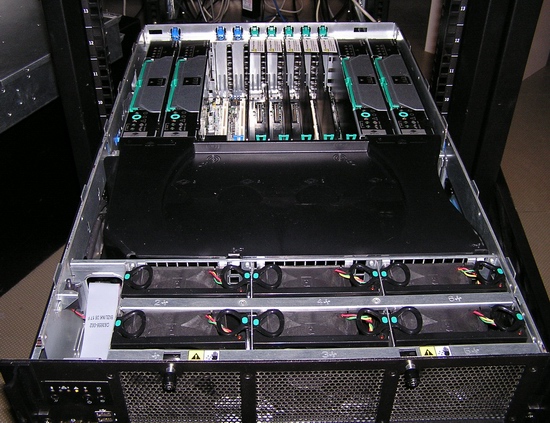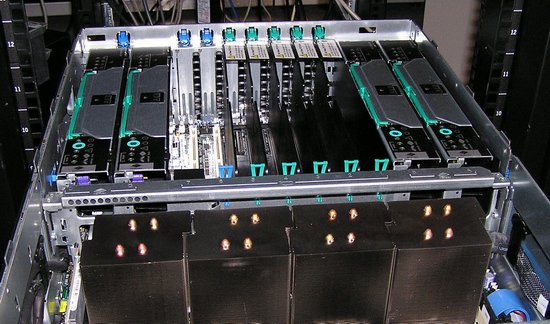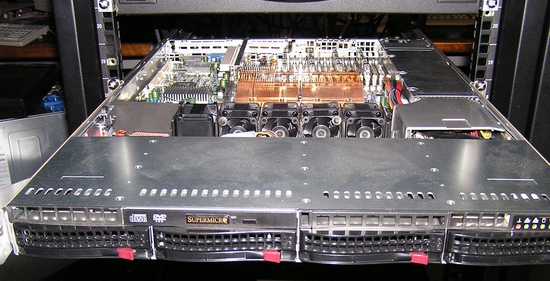Intel's newest Quad Xeon MP versus HP's DL585 Quad Opteron
by Johan De Gelas on November 10, 2006 12:00 PM EST- Posted in
- IT Computing
Intel SR6850HW4 Server
Our server was not a simple demo system, but a complete Intel Server system solution: the SR6850HW4 server. It is an enormous 6U rack/pedestal server, also available in a slimmer 4U form as the SR4850HW4. The main difference is that the 4U server has 5 (6U:10) disk bays, a bit less cooling, and smaller and slightly less powerful power supplies.

Below you can see the massive heatsinks used to cool the Xeon 71xx down.

As the new quad socket Xeon 71xx CPU fits in a 4U server, we can easily compare it with one the most popular quad Opteron servers: the HP DL585.
HP ProLiant DL585 version 2006
The HP ProLiant DL585 available in the labs was not the recently introduced DL585G2 which features DDR2, the new AMD Opteron socket F and 2.5 inch SAS drives. It is a small evolution of the HP DL585 which we reviewed back in 2004. Back then, each of the four CPU boards had 8 memory slots and supported up to 16GB (8x2GB) of DDR-266, for total of 64GB RAM. The original HP was able to use up to 48GB of DDR-333.
The latest DL585 can use 4GB DIMMs, allowing it to access no less than 128GB of DDR266. It can also use 32GB of fast DDR-400 or 64GB of DDR-333, which is very impressive. Below you can find a schematic overview of the latest DL585 technology.

The Opteron keeps a few very important advantages over the Xeon MP, not the least of which is a very elegant platform design. The quad dual core configuration generates more cache coherency traffic, as the 8 cores of the Opteron have to keep 8 L2 caches coherent while the Xeon MP has to keep track of 4 L3 caches. However four 4GB/s full duplex point to point connections make this traffic flow very smoothly while each pair of Xeon MPs have to share a 6.4GB/s half-duplex bus. The Opterons also have a fast 4.8GB/s full duplex point-to-point connection to the I/O chips.
Supermicro SS6015b-8+ server
For the price of a 4U quad socket server you can get several dual socket 1U/2U servers. There are several reasons why you would still prefer to buy the more expensive 4U server: more disk bays, more RAS features, more full height expansion slots, and of course more performance. Depending on your needs one these factors might be the decisive one. In the case of the 4U servers reviewed here, direct attached storage will not be the deciding factor, as you can get 4 or 5 disk bays in a 1 or 2U server too. If performance is the critical factor, it is clear that we must include a 1U or 2U server to see how much more performance you gain if you choose the quad socket machine.
Enter the Supermicro SS6015B-8+, which is equipped with Supermicro's X7DBR-8+ dual Xeon "Bensley platform" server board, based on the Intel 5000P chipset. While it doesn't have the RAS features of the 4U machines (for example, it doesn't have redundant PSUs), it can compete on all other points. In terms of RAM capacity for example, the Supermicro motherboard has sixteen (!) 240-pin DIMM slots that can support up to 64GB of ECC DDR2-667/533 FB-DIMMs. You can also trade in some RAM capacity for RAS: the similar SS6015B-3RV features "only" 8 DIMM slots but two 650W PSUs. The SS6015-8+ is also equipped with a SCSI or SATA backplane that offers 4 drive bays.

Due to the 1U form factor, you have to sacrifice a bit of expandability. One 133 MHz PCI-X slot can support two different riser cards, but not simultaneously. You have to choose between the PCIe riser card and the PCI-X one.
We are well aware that this particular Supermicro server is not a direct competitor. However, a similar 2U server like the 6025B will give almost the same performance numbers. The 6025B Server offers 8 drive bays, redundant power supplies and 6 expansion slots. So we are basically using the SS6015b-8+ as a "performance reference". We will try to answer the question: when do four Xeon MP or Opterons make sense, and how does it compare to the best dual Xeon available, the Xeon DP 5160?
Our server was not a simple demo system, but a complete Intel Server system solution: the SR6850HW4 server. It is an enormous 6U rack/pedestal server, also available in a slimmer 4U form as the SR4850HW4. The main difference is that the 4U server has 5 (6U:10) disk bays, a bit less cooling, and smaller and slightly less powerful power supplies.

Below you can see the massive heatsinks used to cool the Xeon 71xx down.

As the new quad socket Xeon 71xx CPU fits in a 4U server, we can easily compare it with one the most popular quad Opteron servers: the HP DL585.
HP ProLiant DL585 version 2006
The HP ProLiant DL585 available in the labs was not the recently introduced DL585G2 which features DDR2, the new AMD Opteron socket F and 2.5 inch SAS drives. It is a small evolution of the HP DL585 which we reviewed back in 2004. Back then, each of the four CPU boards had 8 memory slots and supported up to 16GB (8x2GB) of DDR-266, for total of 64GB RAM. The original HP was able to use up to 48GB of DDR-333.
The latest DL585 can use 4GB DIMMs, allowing it to access no less than 128GB of DDR266. It can also use 32GB of fast DDR-400 or 64GB of DDR-333, which is very impressive. Below you can find a schematic overview of the latest DL585 technology.

The Opteron keeps a few very important advantages over the Xeon MP, not the least of which is a very elegant platform design. The quad dual core configuration generates more cache coherency traffic, as the 8 cores of the Opteron have to keep 8 L2 caches coherent while the Xeon MP has to keep track of 4 L3 caches. However four 4GB/s full duplex point to point connections make this traffic flow very smoothly while each pair of Xeon MPs have to share a 6.4GB/s half-duplex bus. The Opterons also have a fast 4.8GB/s full duplex point-to-point connection to the I/O chips.
Supermicro SS6015b-8+ server
For the price of a 4U quad socket server you can get several dual socket 1U/2U servers. There are several reasons why you would still prefer to buy the more expensive 4U server: more disk bays, more RAS features, more full height expansion slots, and of course more performance. Depending on your needs one these factors might be the decisive one. In the case of the 4U servers reviewed here, direct attached storage will not be the deciding factor, as you can get 4 or 5 disk bays in a 1 or 2U server too. If performance is the critical factor, it is clear that we must include a 1U or 2U server to see how much more performance you gain if you choose the quad socket machine.
Enter the Supermicro SS6015B-8+, which is equipped with Supermicro's X7DBR-8+ dual Xeon "Bensley platform" server board, based on the Intel 5000P chipset. While it doesn't have the RAS features of the 4U machines (for example, it doesn't have redundant PSUs), it can compete on all other points. In terms of RAM capacity for example, the Supermicro motherboard has sixteen (!) 240-pin DIMM slots that can support up to 64GB of ECC DDR2-667/533 FB-DIMMs. You can also trade in some RAM capacity for RAS: the similar SS6015B-3RV features "only" 8 DIMM slots but two 650W PSUs. The SS6015-8+ is also equipped with a SCSI or SATA backplane that offers 4 drive bays.

Due to the 1U form factor, you have to sacrifice a bit of expandability. One 133 MHz PCI-X slot can support two different riser cards, but not simultaneously. You have to choose between the PCIe riser card and the PCI-X one.
We are well aware that this particular Supermicro server is not a direct competitor. However, a similar 2U server like the 6025B will give almost the same performance numbers. The 6025B Server offers 8 drive bays, redundant power supplies and 6 expansion slots. So we are basically using the SS6015b-8+ as a "performance reference". We will try to answer the question: when do four Xeon MP or Opterons make sense, and how does it compare to the best dual Xeon available, the Xeon DP 5160?










88 Comments
View All Comments
duploxxx - Monday, November 13, 2006 - link
Its nice to say that the new Intel system's have the RAS support and the AMD one not, however keep in mind that you are using an old opteron socket (you can say you have the latest revision 2006).AMD's Opteron 800/200-series (1207-pin, Socket F). The 1207-pin Socket F "Santa Rosa" core AMD Opteron CPU features DDR-2 memory support and Virtualization technology, in addition to Memory RAS security.
Slappi - Sunday, November 12, 2006 - link
Please sell your Intel stock and then rewrite the article please.Thank you,
Slappi
LuxFestinus - Tuesday, November 14, 2006 - link
Taken from Scientia's post here:http://www.amdzone.com/index.php?name=PNphpBB2&...">AMD Forum Board
Kiijibari - Sunday, November 12, 2006 - link
They are misleading as it is unclear what you mean with "mem bandwidth".Is it FSB bandwidth ? System memory bandwidth ? CPU bandwidth ... ?
It is correct that Intel can deliver 21 GB/s from the memory, however one CPU so far can "just" can handle ~11GB/s. So why should 1 Xeon DP have a memory bandwidth of 21 GB/s ? That statement is not valid, if you limit it to one CPU.
Obviously, you meant the System memory bandwidth, but then I really wonder about your Opteron Socket-F numbers ...
First it would be only fair to write the system bandwidth for a 2P System(or whatever compares to the Intel configuration), too. This would be then ~21 GB/s, too, for a 2P Opteron System, 42 GB/s for a Quad System.
Then I wonder how you calculate that 8.5 GB/s mentioned with the Socket-F Opterons.
As far as I know, these chips support DDR2-667 and that means 10.6 GB/s, not 8.5. Please be fair and correct at least that obvious error ...
cheers
Kiijibari
spaceoddity - Saturday, November 11, 2006 - link
Hi Johan,Thank you very much for doing some Linux benchmarks. They are not easy to come by. There are virtually no Linux benchmarks for desktops (perhaps understandable, but frustrating for us Linux users), but for servers, which is where Linux has a sizeable presence, they are always welcome. I hope Anandtech continues to provide good Linux/UNIX benchmarks, and doesn't abandon them for more windoze benchmarks, which are everywhere anyway.
Cheers!
JohanAnandtech - Sunday, November 12, 2006 - link
Well I firmly believe the marketshare of linux servers can only grow and that therefore linux benchmarking will only get more important. A colleague of mine pointed out that Novell has launched e-directory: a very solid alternative to MS Small business server with the same functionality and ease of use, but much cheaper per connection, and with the ability to grow with the enterprise.It is just yet another reason why Linux on servers is so attractive besides much lower cost and much more control over your own IT infrastructure
Justin Case - Saturday, November 11, 2006 - link
In the OpenSSL 1024-bit signs, the quad Opteron has an almost 40% advantage over the Xeon when using 8 threads (in fact, that advantage rises to more than 90% when using optimized binaries), and is still the best of the bunch at 16 threads (32 wasn't tested), and yet the article text completely fails to mention this.It mentions the point where the (more expensive and more power-hungry) Xeon has its biggest advantage (4 threads, with a whooping 9% advantage over the Opteron), and the point where the Sun server (even more expensive) has its biggest advantage (32 threads, but the Opteron wins if using optimized binaries), but completely ignores the Opteron's trouncing of all the competition at 8 and 16 threads, and the fact that the Xeon 5160 cannot scale past its 4-thread peformance at all.
http://images.anandtech.com/reviews/it/2006/tulsa-...">http://images.anandtech.com/reviews/it/2006/tulsa-...
So the fact is the Opteron can handle a load of 10000 signs per second (over 12000 with optimized binaries), while the Xeon can't even reach 6000 (6200 with optimized binaries).
http://images.anandtech.com/reviews/it/2006/woodcr...">http://images.anandtech.com/reviews/it/...rest-lin...
And yet, according to the article, "the Opteron no longerbeats the Xeon". Huh? A 40% advantage isn't enough to win? Who compared the scores, Diebold?
So what if the Xeon performs better when you cripple the Opteron by reducing the number of threads? In any real-world situation, the server admin is going to use the number of threads that delivers the best performance (and is going to use the optimized binaries, of course, if he's competent). Just because the Xeon tops out at 4 threads doesn't mean the (better) results delivered by the Opteron should be discarded.
If this was a "normal" Anadtech article, I wouldn't be surprised by the bias and "selective reporting", but I never expected Johan to "tow the party line" like this.
JohanAnandtech - Sunday, November 12, 2006 - link
From the article:Yeah, I am really doing Intel a favor here, pointing out one of the weaknesses of their core architecture and showing yet another very weak point of Netburst.
Again from the article:
More than one thread per core doesn't give any performance advantage (unless you have a multithreaded CPU) so of course a Dual Xeon 5160 doesn't scale beyond 4 threads, just like a Dual Opteron. As openSSL scales almost perfectly, The important thing here is performance/core, as you don't want to pay for multi socket machine if you don't want to.
You should definitely read more carefully. "Selective reporting" would not include the MySQL, Power consumption or even the NUMA specjbb results as they are favorable for the Opteron.
Justin Case - Monday, November 13, 2006 - link
The fact is, the quad Opteron box reviewed (DL585) _can_ sustain higher performance than the Xeon 5160 (close to 90% higher, using optimized binaries), correct? So, unless the Opteron box costs twice as much as the 5160 box (identically supported and configured, apart from the CPUs / MB), it delivers more bang for the buck.Is this a server test or a CPU core test? It's filed under "IT / Computing", not under "CPU / Chipset", so I have to assume it's supposed to be the former.
So what if one server has twice (or 100 times) as many cores as the other? You might as well argue that the servers must be compared at the same clock speed, with the same amount of on-die cache, or with the same type of memory. All those things might be relevant when comparing CPU architectures (then again...), but not when you're comparing complete systems. The whole point of a server comparison is to see what kind of performance you get for the price. If one server is 70% more expensive but 80% faster, it's still a better deal for people who need the extra performance. That extra performance can be due to a higher clock speed, more CPUs, more cores per CPU, better memory bandwidth, a dedicated coprocessor, magic imps, whatever. But it doesn't make any sense to "compensate" for those variables (or for one of those variables) and ignore the fact that server X can and does deliver better performance than server Y when both make full use of their resources.
At 4 threads, the 5160 is the fastest system of those tested. So what if it has a 20% clock speed advantage? It's still the fastest, right? You're not going to artificially cripple its clock speed to match the others; doing that wouldn't make any sense (because, in the real world, no buyer / server admin would do that). So why cripple the other systems by limiting the number of threads they are running? In that test (with unoptimized binaries), the Sun box reaches the highest performance, period. With optimized binaries, the Opteron box manages to pull slightly ahead. Of course, then you have to take price into account, and maybe for a lot of people the 5160-based server will be the better deal, but you can't say it performs better when, objectively, it does not.
nah - Saturday, November 11, 2006 - link
Great job Johan---as always